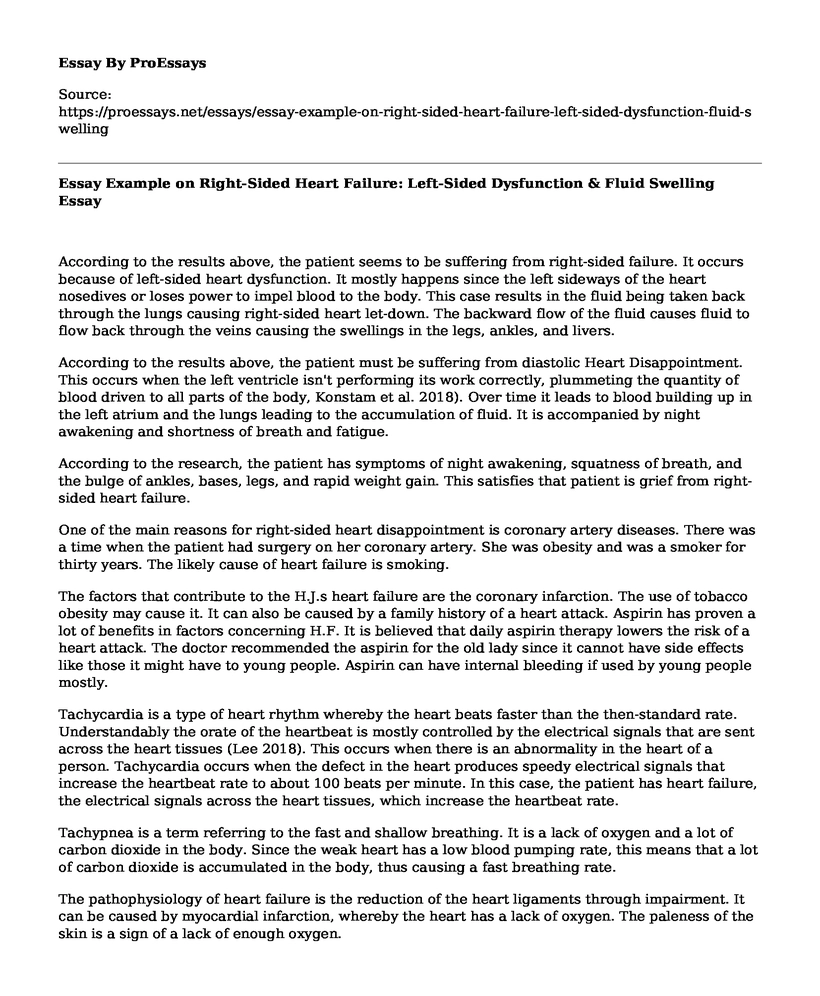According to the results above, the patient seems to be suffering from right-sided failure. It occurs because of left-sided heart dysfunction. It mostly happens since the left sideways of the heart nosedives or loses power to impel blood to the body. This case results in the fluid being taken back through the lungs causing right-sided heart let-down. The backward flow of the fluid causes fluid to flow back through the veins causing the swellings in the legs, ankles, and livers.
According to the results above, the patient must be suffering from diastolic Heart Disappointment. This occurs when the left ventricle isn't performing its work correctly, plummeting the quantity of blood driven to all parts of the body, Konstam et al. 2018). Over time it leads to blood building up in the left atrium and the lungs leading to the accumulation of fluid. It is accompanied by night awakening and shortness of breath and fatigue.
According to the research, the patient has symptoms of night awakening, squatness of breath, and the bulge of ankles, bases, legs, and rapid weight gain. This satisfies that patient is grief from right-sided heart failure.
One of the main reasons for right-sided heart disappointment is coronary artery diseases. There was a time when the patient had surgery on her coronary artery. She was obesity and was a smoker for thirty years. The likely cause of heart failure is smoking.
The factors that contribute to the H.J.s heart failure are the coronary infarction. The use of tobacco obesity may cause it. It can also be caused by a family history of a heart attack. Aspirin has proven a lot of benefits in factors concerning H.F. It is believed that daily aspirin therapy lowers the risk of a heart attack. The doctor recommended the aspirin for the old lady since it cannot have side effects like those it might have to young people. Aspirin can have internal bleeding if used by young people mostly.
Tachycardia is a type of heart rhythm whereby the heart beats faster than the then-standard rate. Understandably the orate of the heartbeat is mostly controlled by the electrical signals that are sent across the heart tissues (Lee 2018). This occurs when there is an abnormality in the heart of a person. Tachycardia occurs when the defect in the heart produces speedy electrical signals that increase the heartbeat rate to about 100 beats per minute. In this case, the patient has heart failure, the electrical signals across the heart tissues, which increase the heartbeat rate.
Tachypnea is a term referring to the fast and shallow breathing. It is a lack of oxygen and a lot of carbon dioxide in the body. Since the weak heart has a low blood pumping rate, this means that a lot of carbon dioxide is accumulated in the body, thus causing a fast breathing rate.
The pathophysiology of heart failure is the reduction of the heart ligaments through impairment. It can be caused by myocardial infarction, whereby the heart has a lack of oxygen. The paleness of the skin is a sign of a lack of enough oxygen.
Pulmonary vein malfunction is caused by the amplified burden of the larger vena cava grounds the pulmonary vein to swell and appear into the skin. The right part of the heart, which is the right ventricle, is for pumping blood (Konstam et al. 2018). Hepatomegaly is also caused by drug abuse, which is part of the patient's failure.
Electrolyte abnormalities are dangerous complications in a patient with heart failure. This is mostly because of the pathophysiological alteration found in the state of heart failure, which leads to the neurohumoral activation. Along with Na+ and Ca+, Mg+ is also used for the cardiovascular function. Magnesium is so important since it is mostly used for the Maintenance of intracellular potassium concentration.
These are the changes in the blood urea nitrogen (BUN) and an estimation of the glomerular filtration rate, which depends on the serum creatinine filtration, which is spontaneously sifted in the glomerulus and not fascinated. In short, urea is filtered and secreted, whereby they are reabsorbed back at a low urine flow rate.
References
Konstam, M. A., Kiernan, M. S., Bernstein, D., Bozkurt, B., Jacob, M., Kapur, N. K., ... & Raval, A. N. (2018). Evaluation and management of right-sided heart failure: a scientific statement from the American Heart Association. Circulation, 137(20), e578-e622.
Lee, K. S., Moser, D. K., & Dracup, K. (2018). Relationship between self-care and comprehensive understanding of heart failure and its signs and symptoms. European Journal of Cardiovascular Nursing, 17(6), 496-504..
Konstam, M. A., Kiernan, M. S., Bernstein, D., Bozkurt, B., Jacob, M., Kapur, N. K., ... & Raval, A. N. (2018). Evaluation and management of right-sided heart failure: a scientific statement from the American Heart Association. Circulation, 137(20), e578-e622.
Cite this page
Essay Example on Right-Sided Heart Failure: Left-Sided Dysfunction & Fluid Swelling. (2023, Mar 02). Retrieved from https://proessays.net/essays/essay-example-on-right-sided-heart-failure-left-sided-dysfunction-fluid-swelling
If you are the original author of this essay and no longer wish to have it published on the ProEssays website, please click below to request its removal:
- Aging Parents Essay Example
- Child Health Safety and Nutrition Resource Paper Example
- Whose Hospital Is Brendan Hospital? - Essay Sample
- Public Health Nursing: Enhancing Population's Health Through Social & Nursing Practices - Essay Sample
- Civic Education in K-6 and 9th Grade: Essential for Effective Participation in Public Life - Essay Sample
- Remote Collaborations: Navigating Challenges During Covid-19 Outbreak - Essay Sample
- Nurturing Effective Communication and Holistic Care: Strategies for Dementia and Hearing-Impaired Patients







